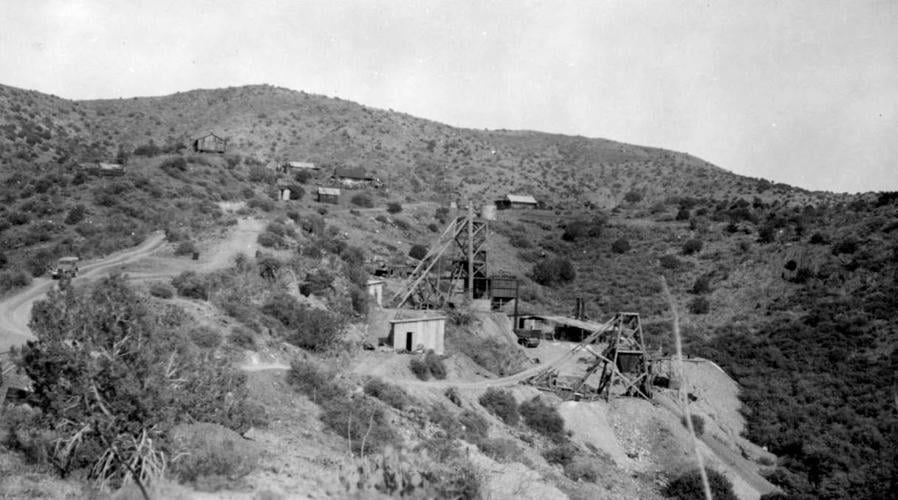The Red Rover Mine, located in the Magazine Mining District about 32 miles northeast of Phoenix near the headwaters of Cave Creek and Bloody Basin, has a long history of intermittent mining as first evidenced by Spanish workings.
Modern mining at the site began in 1882 with Dr. D.W. Craig, president of the Red Rover Copper Mining Co., who noticed the surrounding gossan (decomposed rock appearing reddish-brown due to a concentrate of iron minerals) outcrops in limestone showing copper and silver stains.
In many cases the gold, copper and silver had been leached by natural weathering processes.
However, in some cases occasional shoots — or kidneys — of ore remained, carrying values of $10 to $60 per ton.
First production came from stringers near the surface, followed by the development of an incline shaft.
Ore transport was by burro to El Paso and later by truck to a railhead at Phoenix.
Between 1882 and 1917, the mine produced $200,000 in copper and silver. Early copper ore averaged between 15 to 25 percent per ton. Silver chloride located near the surface netted a profit of $41,000 for one carload weighing 20 tons.
Frank A. Gillespie of Tulsa, Oklahoma, acquired the property for $600,000 in 1916. He modernized the operation with the necessary compressors, hoist and oil engines. He also built a mill to accommodate flotation machinery.
The mill proved inefficient in processing the quality of the ore.
By 1920, the mine was developed to 10,000 feet of underground workings, including a 200-foot tunnel and a 500-foot incline shaft.
A 10- to 16-foot orebody between limestone and porphyry was identified consisting of a 3-foot paystreak averaging 10 percent copper and 6 to 60 ounces of silver.
Ore shipments made by lessees were sent to the Hayden smelter carrying 30 to 60 ounces of silver per ton and 3 to 6 percent copper per ton over the next several decades.
Henry P. McNeill and Lawrence M. Tozier leased the property in 1965 and sent ore for processing to the I.C.C. smelter at Miami, Arizona.
Westec subleased the property from McNeill, conducting mapping and sampling reopening the shaft to the 300 level.
Attempted diamond drilling proved ineffective due to the highly leached nature of the rock.
The company did add a power plant, a 600 cubic-foot-per-minute compressor and a 500-foot capacity Coeur D’Alene hoist to service the 360-foot incline, along with a 30-foot-high steel headframe.
At the time, the vertical shaft was over 900 feet deep, though much of that depth was submerged in water.
McNeill later claimed that the flotation tailings at the Red Rover contained significant gold chlorides . He used sodium thiosulphate to treat the material by leaching and later smelting the precipitate.
A 1967 assessment of the property stated $778,734 of recorded historical production with 20,000 tons of ore produced. A figure of over $1 million would include unrecorded production.
The mine’s remote location, combined with the nature of unorganized operations limited to high-grade pockets of ore found in the oxide zone, reduced its ability to produce in significant quantities.
Inadequate pumping facilities failed to accommodate the rising water inside the mine, negatively impacting operations.
Other reports, including one from the late mining engineer Charles Dunning, stated that if the mine were further developed, a massive sulfide-type deposit might be accessed, opening up a zone of moderate-grade commercial ore.
In the 1990s, the Arizona Mining and Mineral Museum in Phoenix acquired several mining artifacts from the Red Rover owned by the Tozier family, including several muckers and ore cars.
A 1930s air-operated mucking machine from the Red Rover was placed in front of the museum’s entrance .
The mine also contains an original machine shop, replete with tools submerged under several hundred feet of water.





